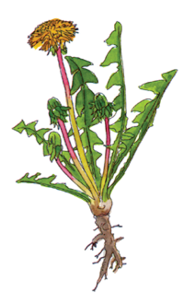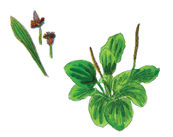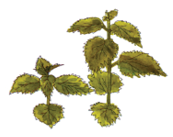
Edible & Healing Plants in Your Own Backyard
Many plants commonly considered weeds are nutritious & medicinal.
by Kate Lancaster | illustrations by Brenna Quinlan
Before I learned about their medicinal qualities, there were many plants I believed were undesirable weeds that I certainly wouldn’t have eaten. My relationship with plants has changed; instead of waging war on weeds, I’m now grateful they grow in my yard and I enjoy learning about them.
Many plants that grow wild are edible and/or have medicinal properties. These are four of my favorites. (The nutrient information I’ve included comes from the book Edible and Medicinal Plants of the West by Gregory L. Tilford. As with any new food or supplement, test cautiously to see how your body responds.)

Dandelion
DANDELION (Taraxacum officinale)
Every part of this plant is useful. Dandelions are high in vitamins A, C, E, and B- complex and provide iron, protein, and trace minerals. Young leaves (best harvested in the Spring) add spice and valuable nutrients to any salad or can be cooked like spinach. The roots can be chopped, dried and used in teas.
There are many lookalikes, so here are a few tips to identify dandelions. The lion-tooth shaped leaves emerge from the center of the plant and are not fuzzy or spiny. Individual flowers emerge from the center of the plant and are on a single leafless stalk that is purple at the base and oozes a milky-white sap when you break it. Dandelions have long taproots that draw nutrients from the soil.

Plantain
PLANTAIN (Plantago major and lanceolata)
We have both broad and narrow-leafed species of plantain in this area. The leaves are edible – Tilford likens it to Swiss chard and says it is high in Vitamin C, A, and K. The flowers are not noteworthy, but the seeds are a wonderful source of fiber and are a laxative. This plant is called the “band-aid” plant. A poultice (pick a leaf and chew it until it is pulverized or blend with a little water) placed on any wound is soothing and reduces inflammation. I applied a plantain poultice when I had a bee sting and the swelling and pain was much diminished.

Self-heal
SELF-HEAL or HEAL-ALL (Prunella vulgaris)
Self-heal is another I used to pull up, but it has become one of my favorites. I’d change the name from Prunella Vulgaris to something that reflects how sweet this plant is. The more I learn about it, the more excited I am to have it growing in my yard. The whole plant is edible (best when young) and can be eaten either raw or cooked. It is high in vitamin B12, D, E and provides magnesium, copper, selenium and zinc.
Self-heal has antibiotic, anti-inflammatory and antioxidant properties. A poultice of leaves helps wounds heal and the leaves and flowers make a slightly sweet tea that soothes sore throats and reduces respiratory infections.

Nettle
COMMON or STINGING NETTLE (Urtica dioica)
This plant deserves both our respect and appreciation. The stems and leaves have stinging hairs that cause a burning and numbing rash. I have read that the sting helps reduce arthritis pain, but I personally don’t relish the sting. Harvest carefully with thick gloves, wearing long sleeves and pants. Despite these cautions, nettle is a very beneficial plant. It’s high in iron, calcium, potassium, manganese and vitamins A, C, and D.
Nettle is best harvested when the leaves are young and tender (as the plant ages it becomes tough and the burning particles can irritate your urinary tract if eaten). You can cook and use nettle like spinach in lasagna and soups or stews or substitute nettle for basil in pesto. The leaves can also be dried to prepare as a refreshing and nourishing tea.
Each of these plants has many more uses than I mentioned here. There is much to learn as you explore edible and medicinal plants in your backyard and beyond. The directory sections ‘Education: Growing Food’ (page 80) and ‘Medicinal Herbs’ (page 115) list additional local resources.
. . . . . . . . . . . . . . . . . . . . . . . . . . . . . . . . . . .
Kate Lancaster (she/her) recently retired from HSU as an accounting and sustainable business professor. Her passions are small-scale permaculture gardening, learning about medicinal plants, and walking with her dogs in the Redwoods.
. . . . . . . . . . . . . . . . . . . . . . . . . . . . . . . . . . .
| Foraging Ethics
Learning about forageable foods is a wonderful way to eat healthily and source locally. However, there are a few things to consider. It’s important to forage away from roads to avoid pesticides or insecticides and to ask permission before you forage on tribal lands or private land. Be aware of the impact you have on the plants and the area where they grow. Ecologist and enrolled member of the Citizen Potawatomi Nation, Robin Wall Kimmerer offers these thoughtful guidelines on how to forage and harvest in a sustainable and responsible way. She refers to this as the “Honorable Harvest.”
|